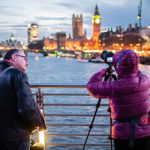The built-in flash on a digital camera is compact, simple to use, and often effective in providing the extra illumination needed to assure adequate exposure of a subject when ambient light is insufficient. In some instances, the internal flash is able to soften shadows in harsh light as well. So why then, would the average, non-professional photographer need or want an external flash for their camera?
More illumination is sometimes needed.
The built-in flash on the average digital camera has a useful range of about 13 to 15 feet. An external flash has more power and can illuminate a larger area; their range can be as large as 70 feet. Whether trying to illuminate a large group of people only 15-20 feet away or a single subject 50 feet away, an external flash can provide much better lighting in such situations. An external flash is particularly useful when shooting with a wide angle as many can disperse the flash to fill the width of the scene.
Shadows can be excessively harsh when illuminating a subject directly.
The internal flash on a digital camera shines directly in front of the camera lens onto a subject and can create shadows behind them when it is the primary source of lighting. An external flash offers the user greater versatility with models that tilt, swivel, and many that can be positioned well away from the camera body. An external flash can create lighting from different angles and can be bounced off of a white ceiling or reflector to significantly soften any shadows and reduce any glare. The ability to have the flash moved away from the camera lens also helps to eliminate the red-eye effect as the light is not reflected from the eyes of a subject directly back into the lens.
Slow flash recycling can make it difficult to take shots in rapid succession.
The typical built-in flash on a digital camera can take several seconds to recycle after being triggered during which time additional shots with the flash are not possible. An external flash is often able to recycle in less than a second and thus allows multiple shots to be taken in rapid succession.
As lighting is generally considered the single most crucial factor in the quality of the image captured, using an external flash with a digital camera would seem to be an excellent choice. However, there are instances in which a user might wisely opt to forgo the additional expense and complexity of using an external flash.
Compact size or sleek styling is of primary interest to the user.
An external flash is large, bulky, and certainly does not lend itself to going unnoticed. They cannot be toted around in a pocket and thus are not a good choice for casual use.
Ease of use is critical.
An external flash often requires the user to manually adjust settings. For the most simplicity, a TTL flash (through the lens) is the best choice versus a non-dedicated or slave flash device, as a TTL flash communicates with the camera and triggers automatically. The process of purchasing an external flash can also present some complexity as the buyer must assure that the camera and flash are compatible, that they will communicate or connect (via hot shoe, cold shoe, sync-cord, adapter, and so forth) and that the voltage on any flash device that connects to their camera will not harm their camera circuitry.
Budget constraints.
An external flash, as with any auxiliary or accessory device, adds cost. The average flash will add $140-$500 to the total cost of a camera. In addition to the up front cost of the device, an external flash can also consume a significant amount of battery power adding to the life time cost of the camera.
Use of an external flash with a digital camera can significantly improve the quality of images created by giving the user much greater control over lighting. However, these devices do add another level of complexity as well as cost to the photo taking process. First time buyers merely need to weigh which features are most critical for them to determine whether or not an external flash will be a good investment.
The author, Christine Peppler, encourages readers to visit her website at http://www.homemedias.info for more information about using or selecting a camera, accessories, or other home electronics devices.
Like This Article?
Don't Miss The Next One!
Join over 100,000 photographers of all experience levels who receive our free photography tips and articles to stay current:








Extremely useful article! Thanks for writing it. I admire your night photography btw.